If winning back-to-back championships establishes dynasties, what do you call it when you win 10 years in a row?
In Chicagoland, they hand the ball to the ref and they act like they’ve been there before. Because they have.
The 2022 data on corporate facility investment nationwide indeed tell a familiar tale: The multi-state Chicago metro area is No. 1 (with 448 projects) and the next three metro areas in the rankings also repeat their rankings from last year: Dallas-Fort Worth-Arlington is No. 2 (426 projects); Houston-The Woodlands-Sugar Land is No. 3 (255 projects) and New York-Newark-New Jersey is No. 4 (246 projects). The biggest upward mover in the Top 10 is Los Angeles-Long Beach-Anaheim, California, with 150 projects, just ahead of repeat No. 6 metro Atlanta-Sandy Springs-Roswell, Georgia.
In the per capita category, this year’s rankings are topped by No. 1 Austin-Round Rock and No. 2 DFW in Texas, followed by three multi-state metro areas in a row: No. 3 Cincinnati, No. 4 Chicagoland and No. 5 Louisville/Jefferson County, which moves up from No. 7 last year.
A noteworthy recent statistic from Kastle Systems (based on building access control data) finds that among 10 major cities analyzed by how many office workers had returned to the office during a week in February, Austin, Chicago and Houston were the only cities with returned-worker percentages higher than 50%. Michael Fassnacht, CEO and president of World Business Chicago and chief marketing officer for the City of Chicago, says his city’s downtown is doing just fine.
“Young talent, post college, they want to be in an urban center,” he tells me, for the entertainment, night life and diversity of people and experiences. “We have not seen a dropoff. We have seen an influx from the coasts because it’s more affordable and there are more opportunities.”
That influx is coming from companies as well as talent. Despite the rise of Los Angeles this year to No. 5 from No. 8 last year among our Top Metros, Fassnacht says he learned during a trip to L.A. early this year that “a lot of L.A.-based companies are interested in expanding into the Midwest and it looks like Chicago is the gateway. In 24 hours we met 50 companies and 12 are seriously interested.”

The Austin-Round Rock metro area is this year’s No. 1 metro in corporate facility projects per capita.
Photo by Carlos Alfonso courtesy of Unsplash and PropTechOS
Places for People
As for the people those companies might employ, Fassnacht says, “I think young people cannot build a true career virtually.” Even after Google Mobility data showed Chicagoans’ time spent at workplace locations through much of 2022 was 20% to 30% lower when compared to January 2020, he says, “The majority of companies are going to three to four days a week in the office, and the numbers are going up slowly in office presence.”
Companies are also rethinking what a modern headquarters looks like. “It’s not one building,” he says. “It’s still important, but not everyone has to be there. Regionally, I would not be surprised at more of a hub-and-spoke model. Look at Abbott, which has their headquarters [in Abbott Park in the far northern suburbs between Lake Forest and Waukegan] but now also an office presence downtown with 450 employees in Willis Tower.”
Center-cities are not metro areas, but concerns have risen about the hollowing out of downtowns in metro cores. In a recent Volcker Alliance briefing on “The Future of Downtowns,” panelists painted a mostly gloomy picture, talking about the “urban doom loop” some cities such as San Francisco have spiraled into since the onset of the pandemic and the work-from-home mindset. Tracy Hadden Loh, fellow at the Anne T. and Robert M. Bass Center for Transformative Placemaking at Brookings Metro, said the hollowing out was an opportunity for reimagining downtowns.
“My personal sense is that they are not all doomed,” she said. “Telework is here to stay, but it is not clear levels of telework have stabilized for the near or long term. There is also evidence that work agglomeration increases productivity. There is good reason to expect more RTO [return to office] than there has been so far.”
She said the time is ripe to adjust zoning and other rules so housing could grow in downtowns at a time when it’s needed more than ever. Convert office buildings to residential, thus giving downtown restaurants and other businesses opportunities to serve an evening crowd and not just a lunch crowd.
Populating downtown after 5 p.m. was on the minds of leaders in No. 9 Top Metro Des Moines 20 years ago. So they did something about it.
“We put in super-aggressive incentives for housing,” says Mike Swesey, executive vice president of the Des Moines Partnership. Now, unlike many places in the nation, in Des Moines there is plenty of housing. “A lot of the apartments downtown received 10 years with no taxes,” he says. “Now we have more than 15,000 people living downtown. There’s a new pro soccer stadium going in with housing nearby. With projects announced we will have another 5,000 living downtown. We’ll have housing into the foreseeable future.”
That pairs nicely with daytime downtown foot traffic that Swesey says is back to 85% of pre-pandemic levels, whereas the national average is just below 50%. Among other things, he says, the Partnership has put a lot of effort into holding events downtown.
“Connect the wellbeing of people and places that have been hurt by the pandemic so they all can grow,” Brookings’ Tracy Hadden Loh said in the Volcker Alliance discussion. “Cities that invest in being a great place to live will be great places to work.”
That syncs well with Chicago leaders’ thinking.
“You are seeing a reimagination of these key critical corridors. Affordable housing is part of that,” Fassnacht says. He sees some of Chicago’s key downtown commercial corridors shifting from, say, 95% commercial to 70% or 60% commercial, with more mixed-use and entertainment uses. Contrary to the planning sins of the past where freeways blasted through neighborhoods, new projects are connecting them instead. “I’m optimistic on this,” he says. “There will be more things coming.”
Irons In the Fire
That sort of regional thinking goes hand in hand with the Greater Chicagoland Economic Partnership, a three-year commitment announced in January among the city, Cook County and six other counties that each will contribute $1 million with the aim to strengthen the overall global competitiveness of the Chicago region well beyond the core city and its 77 neighborhoods.
“On behalf of the region’s business community we applaud the work that went into convening and cementing this united, regional effort,” said Ryan Smith, executive vice president, Ajinomoto Health & Nutrition North America, at the January announcement. “This is a distinct competitive advantage for businesses operating and located in the Chicagoland region.”

“The ability to share information and pool our resources makes this partnership truly a win-win for DuPage, Cook, the collar counties and the City of Chicago,” said former DuPage County Chair Dan Cronin, a longtime proponent of the partnership concept. “If we want to truly thrive, a strong regional economic development effort is essential.”
Or, as Fassnacht puts it, “We don’t want to poach anymore.” Administrations for decades have pushed for such a regional coalition and now it’s finally taking shape despite the stubbornness of siloed thinking. “I met with CEOs,” he says, “and they said, ‘It’s not about having an HQ moving discussion. How can we generate more stickiness?’ If a company looks at the Midwest and three sites, with one in the city and two in the suburbs, we say here are the pros and cons, and the company makes a decision. It’s about trust. We have to prove we deserve the trust every single day.”
Tech & Manufacturing, Living Together
Fassnacht noted positive trends in private equity, venture capital and the metro’s targeted sectors of transportation, distribution and logistics; manufacturing; life sciences and healthcare; and tech. That last sector is where the digitalization of the economy is taking place, a phenomenon being studied right now by Mark Muro, senior fellow at Brookings Metro, with his colleague Sifan Liu, in the context of place-based policies. They have studied the digital content of 761 U.S. occupations covering 98% of the workforce in all industries and then assigned digitalization scores to all metro and micropolitan areas based on a 0-100 scale where a score of 60 or above marks an occupation as “highly” digital, and one above 33 but below 60 is deemed a “medium” digital occupation. Many locations that exhibit high digital scores are college towns and government centers such as state capitals. National labs help too.

Mark Muro, Senior Fellow, Brookings Metro
Photo courtesy of Mark Muro
“Across the nation’s 56 biggest metros, as much as 30% of all jobs were highly digital as of 2020, while low-digital jobs encompassed just 22% of the workforce,” they write. “By contrast, highly digital occupations account for only 20%of the workforce in the nation’s more than 500 micropolitan areas, where low digital jobs account for 26% of the total. And pay gaps reflect those divides.”
A handful of highly digitalized economies appear among this year’s Top Metros. Asked to comment, Muro says, “Austin, Boston, and Washington are each in the top echelon of digitalized economies. The digital score of each of these places exceeds 50. Such places tend to be sizable, have strong service sectors, high BA attainment, and state government.”
Austin scores well on a separate new scorecard too: Real estate technology company ProptechOS looked at 11 indicators of a smart city (broadband download speeds, tech jobs, EV charging points, etc.) across three categories in the 100 most populous cities in the U.S. and Europe. They found Austin to be the smartest city in the U.S., followed by Los Angeles, Seattle, San Francisco and Atlanta. Austin scored particularly highly on tech infrastructure and green infrastructure, with, for example, the eighth-highest number of publicly accessible EV charging stations in the country, and the eighth highest number of Internet of Things companies headquartered and operating there.

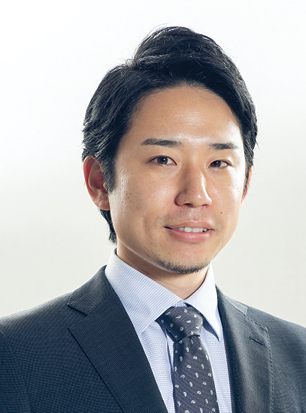
CADDi CEO Yushiro Kato
Muro says big professional business cities like Atlanta, New York, Dallas, and Houston are just below the likes of Austin in digitalization, driven by “huge professional services, business, and health sectors that continue to become increasingly digital.” No. 5 Tier-2 metro Dayton-Kettering, Ohio (No. 1 last year) has a score of 49, while Tier-2 No. 3 Omaha-Council Bluffs and No. 9 Des Moines-West Des Moines come in with solid 48s.
Chicago’s score of 48 is helped by the presence of tech firms like CADDi, a 600-employee Japanese global supply chain company that in January announced it was establishing a new office in Chicago where it hopes to employ up to 100 people within fiscal 2023. As a one-stop service for procurement and manufacturing, CADDi leverages its supply chain infrastructure to provide sheet metal and machined parts, along with frames and tanks, as well as plastics and wire harnesses.
“When I spoke with our customers at their factories,” said Yushiro Kato, CEO of CADDi, “what stood out to me was their strong sense of urgency to modernize their supply chain. That’s why I felt that we needed to move quickly and expand our business.”
The Uber of Supply Chain?
Why Chicago? I posed that question to Michael Hashimoto, CADDi’s technical sales director in Chicago, who brings an extensive automotive and engineering background and an international resume to his position. After coming to CADDi in 2021, he found himself tasked with finding a suitable location for the company in the U.S., the company’s fourth country after offices in Japan, Thailand and Vietnam.
“All I had in mind was to select the location which be suitable for us to unleash the potential of manufacturing the most in the U.S.,” he says, prior to showing me a demo of the company’s lightning-quick system for scanning parts design documents and presenting spec-specific procurement solutions across a global web of suppliers. He describes CADDi’s business proposition by way of analogy. Just as Uber replaced the taxi and Airbnb targeted traditional hotels, CADDi aims to replace the current procurement and purchasing business by using its technology and skills to ease customers’ processes as much as possible. It’s a $90 billion global market, and CADDi already has worked with 1,600 companies in its five years in existence.
“I started doing research on manufacturing companies and found out California has the most manufacturing companies, followed by the Midwest,” he says.
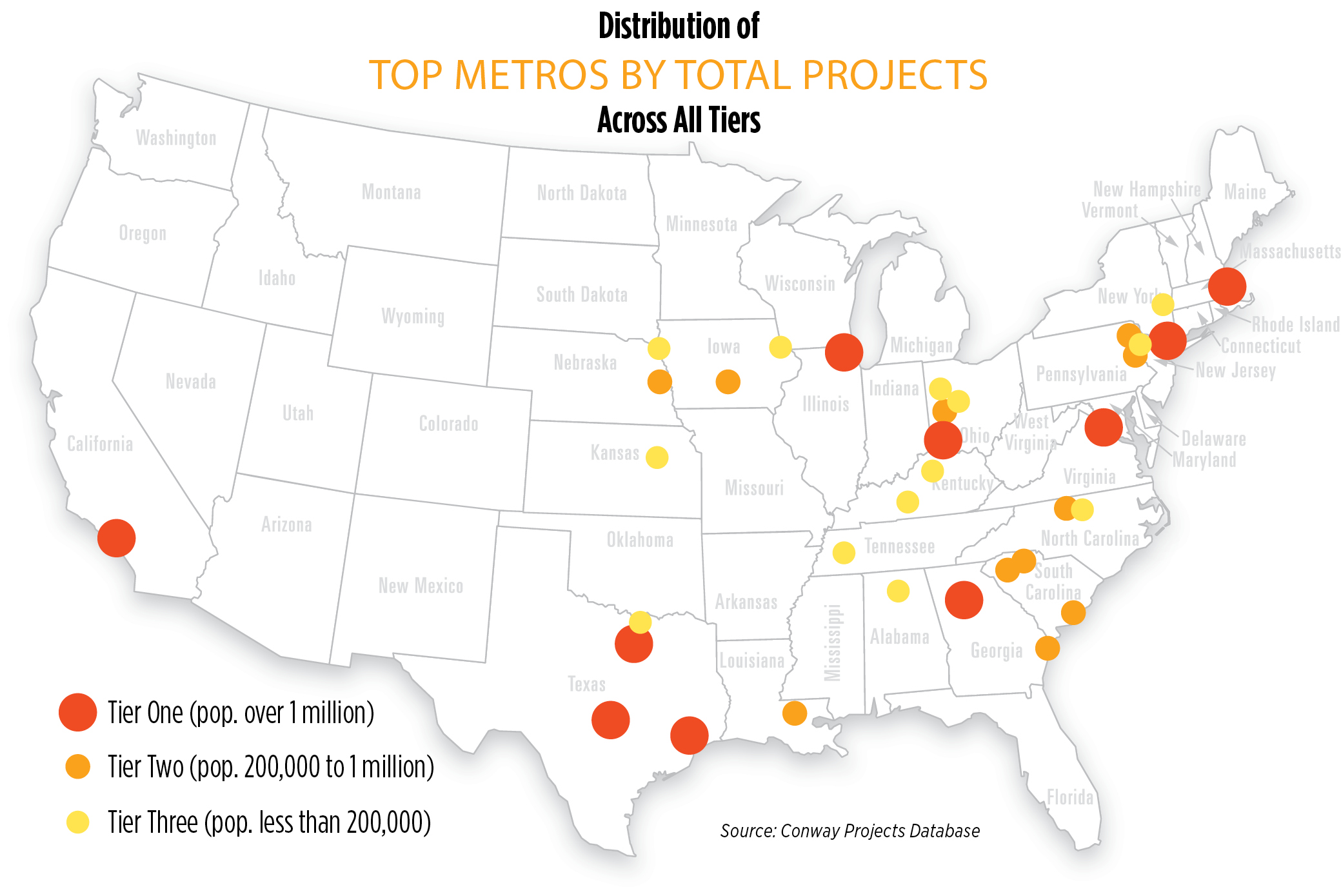
California therefore was going to be the winner until the CADDi team started talking to suppliers and learned that even though companies’ headquarters might be out west, the heartbeat of their manufacturing network was in the Midwest. Moreover, Hashimoto says, “we started to find out that more manufacturing companies are suffering in maintaining their quality, cost of delivery and performance around Illinois” and therefore were most in need of support.
“The second reason we selected Illinois was there are many talented manufacturing people around here. That is a very important point for us,” he says. The company is looking to hire competent process engineers, quality assurance and control engineers, and that talent is not in short supply in Chicagoland. “Our company is a technology company, but we have strong skills in manufacturing — around 50% of our 600 employees come from a manufacturing background,” Hashimoto explains. “Those are the people who will go to the customer or suppliers and talk in the same language, understand their needs and issues, and solve them together.”
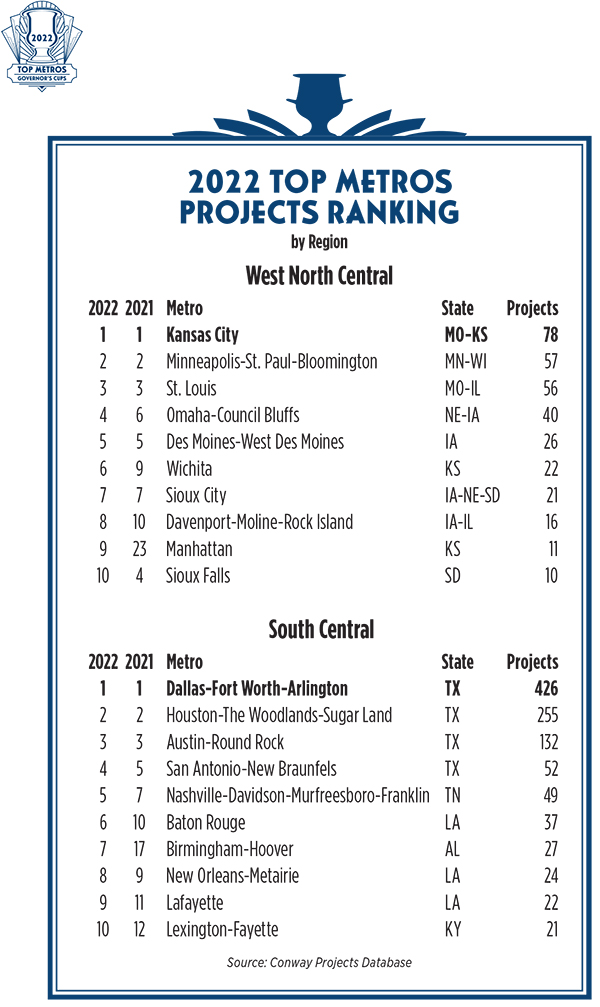
Getting to those customers easily was the third reason to pick Chicago, he says. Chicago O’Hare International Airport — just like the vintage TV commercial depicting a boss handing out United Airlines tickets to all of his team members in order to get back in touch with customers — makes it easy to go visit them on cue. And make no mistake: He sees plenty of customer potential.
“There are three reasons,” he says. “One, the number of suppliers is decreasing. Two, the cost in Mexico has been increasing, so the customer needs alternative solutions. Three, due to the trade war between the U.S. and China, a lot of customers need to change from China. So what we are doing right now is supplying parts from Asia at the same time we’re developing suppliers in the U.S.”
Ultimately, he says, “We are using technology to prevent customers negotiating with suppliers and wasting time. If we can prevent wasting time, the manufacturers will be able to focus more on value-added work — product development, process engineering, marketing. That is the goal we want to achieve. That means the potential of manufacturing is unleashed.”
If there is any metro area ready to assist in that endeavor, the City of Big Shoulders is it.
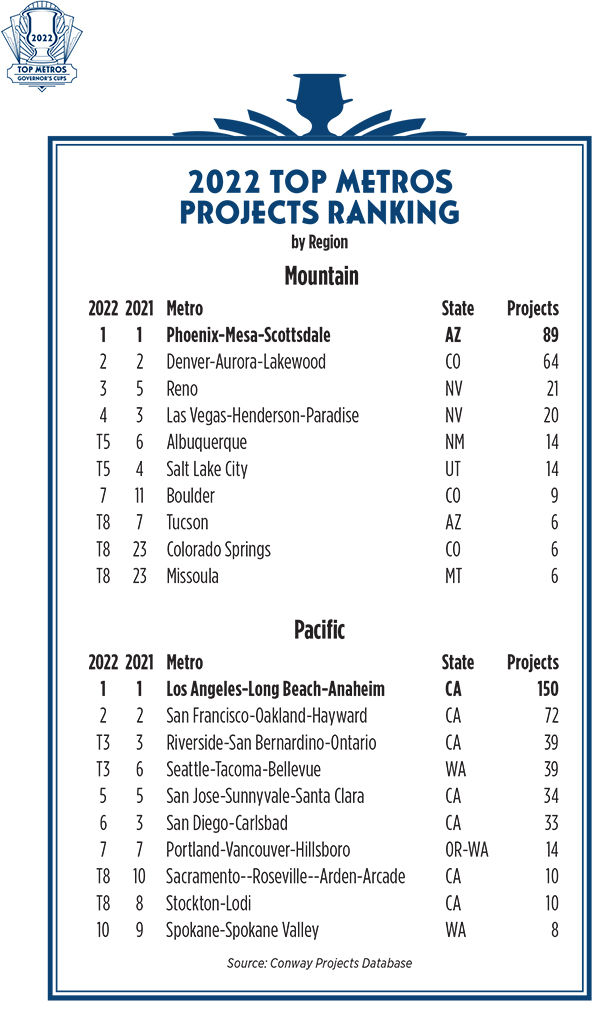 Upstate South Carolina Sweeps Tier-2 Metros
Upstate South Carolina Sweeps Tier-2 Metros
Topping the Tier-2 population category in 2022 were Greenville-Anderson-Mauldin, South Carolina by overall projects and neighbor Spartanburg, South Carolina, in the per capita category. In other words, the Upstate is still on an upswing.
Among other sectors, the region is known for its cluster of professionals engaged in what this publication documents: corporate site selection. One such firm is Global Location Strategies. Many of the firm’s staff hail from the Upstate and are as fervent homers for their region as they are for the sports teams of Clemson University or the University of South Carolina. But some of them come from away. Take Tess Fay, a principal of the firm who came to the area a few years ago.
“Hailing from Kentucky, I was a bit hesitant to move to Greenville when Global Location Strategies first offered me a consultant position. Like most of today’s young workforce, I was at a point in my career where I was willing to make the leap but wanted to make sure the place was the right fit and could be a future home where we could grow our family. In 2019, I relocated to the Upstate. As I started to explore my new stomping grounds, what was immediately apparent was the intentional investment downtown — a decades-long transformation full of perseverance and a clear vision, that not only is appreciated by residents, but attracts more than 5 million visitors to the region every year. Over the years, I’ve recognized that this visionary mindset and intentional investment extends beyond Greenville to the surrounding communities like Greer, Fountain Inn and Travelers Rest. And this breadth of options gives Upstate residents limitless things to do and places to discover. The community pride is apparent, an X factor not easily cultivated, and is integral in making a company feel at home when considering the Upstate for a new location, particularly if they relocate employees here.”
I reached out to John Lummus, president and CEO of the Upstate SC Alliance, for insights:
Site Selection: They may be officially separated as metro areas by government definition, but everyone I know still thinks of the region as Greenville-Spartanburg. Describe how you manage the dance between regional branding and official names of jurisdictions that also compete for projects (and for government funding streams) on their own.
John Lummus: The Upstate Alliance represents us as one region: the Upstate of South Carolina, home to 1.6 million people across 10 counties. These No. 1 rankings are a fabulous recognition for both Greenville-Anderson-Mauldin and Spartanburg, though we look at the two victories as two achievements that acknowledge the collective economy of the Upstate. We help companies explore doing business in the Upstate by sharing our collective assets — things like GSP International Airport; the Inland Port in Greer; Clemson University, Furman University and the 26 total colleges and universities producing graduates across our region. When it comes to the real estate search, we connect prospects with all Upstate communities that fit their search parameters and step out of the process. Just as the rankings are a win for the region, I look at any project landing within the Upstate as a win across the Upstate.
Walk me through 1-2 specific corporate locations or expansions that stand out to you from 2022.
Lummus: BMW’s continued growth in the Upstate stands out as the leading investment from 2022 with $1.7 billion for batteries and electric vehicles will have a huge impact on the region. The company is prioritizing local sourcing and has stamped South Carolina as “where X goes electric,” and that stands to have a ripple affect across the region. The Health Supply US investment of $150 million and 600 jobs is an interesting one for its focus on American-made nitrile gloves. In discussing the announcement publicly, CEO Christopher Garcia emphasized that the company chose to realign supply chains following the complications of 2020, and bringing that life sciences investment to the U.S. was a direct result. Another neat project that falls outside of the two MSAs is MycoWorks, a California-based biotechnology company that specializes in mycelium-grown materials (simply put: “vegan leather alternative”) for use as sustainable, luxury-quality leather alternatives. The company invested $107 million in production operations in Union County and will create 400 jobs. With customers like Hermes, they’ve been in lights at Paris Fashion Week and the focus of media exploring the potential of bioengineering for sustainability.
Which other communities in these two official MSAs are growing but perhaps not yet on everyone’s radar?
Lummus: The entire Upstate region is growing. In Anderson, one trend is how existing employers are expanding to accommodate emerging innovation. Examples include Bosch’s $200 million investment to produce fuel cell technology that will drive hydrogen-powered Class 8 trucks, and automation equipment designer and manufacturer Kelley Engineering’s $6 million investment. Interestingly, both companies are generating products used in industrial applications.
In Mauldin, there’s both growth in population and in mixed-use capabilities. In recent years, they’ve welcomed office jobs characterized by financial and customer services. A $100 million mixed-use, urban village project called BridgeWay Station is under construction.
It’s hard to single out additional “growing” communities because ours all are, and they bring different traits to the mix. Fountain Inn is experiencing a surge in residential and commercial, and it’s a border community between Greenville and Laurens counties. Neighboring Simpsonville, a residential community that’s proud to be “Simply Home,” has a growing leisure scene. On the industrial front, the town of Woodruff is bringing growth to Spartanburg County as BMW is establishing a high-voltage battery assembly facility there that will create 300 jobs and span more than 1 million square feet.
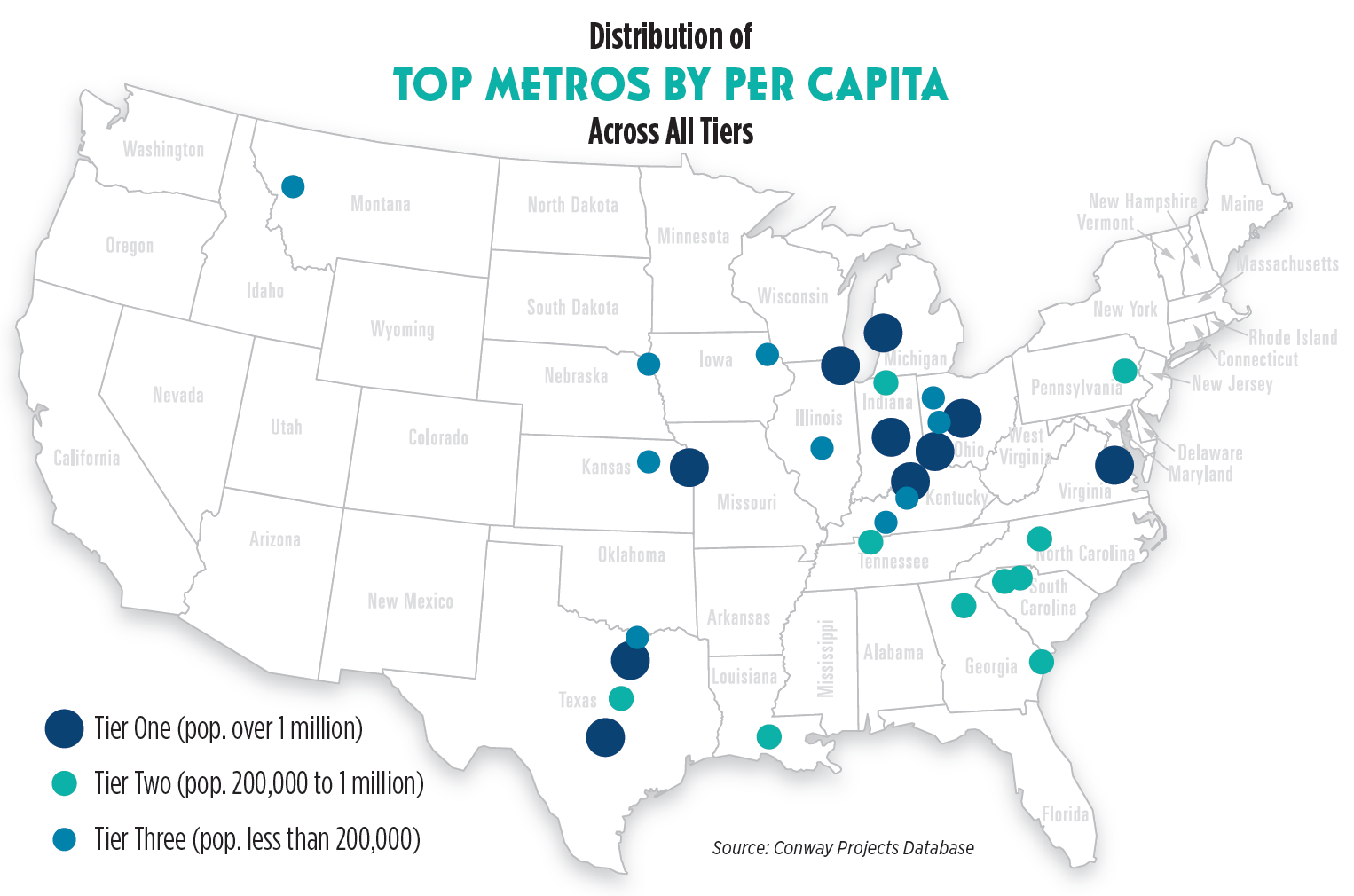
Tier 3: Superb Sioux City Again Tops Cumulative & Per-Capita Rankings
No matter how you slice the data, it seems the tri-state area of Sioux City, Iowa-Nebraska-South Dakota, always comes up roses. This year the region repeats its feat of the No. 1 ranking by total projects and No. 1 ranking by total projects per capita among Tier-3 metros (those with populations between 50,000 and 200,000).
The region is not alone at the top. Three other communities appear in the top four of both rankings, in slightly different order: Lima, Ohio; Bowling Green, Kentucky; and the upstart university town of Manhattan, Kansas, which was unranked in both categories the previous year. Toss in each category’s No. 5 finishers Dubuque, Iowa, and Elizabethtown-Fort Knox, Kentucky and you have a veritable Midwest-fest.
Among the projects landing in the area was a $185 million, 149-job expansion by pet health nutrition company Royal Canin in North Sioux City, South Dakota. It was helped by a nearly $4 million Reinvestment Payment Program grant from Governor Kristi Noem’s Office of Economic Development. It was also helped by the pet care habits of a nation.
“Over the past two years, the country experienced a boom in pet ownership and heightened focus on pets’ health,” said Royal Canin North America President Cecile Coutens, “Royal Canin is seeing significant growth as a result … We already know what an incredible place the North Sioux City community is and are thrilled to expand our presence here.”
Other investors last year included Cargill, MidAmerican Energy, Thompson Equipment Co. and Cold-Link Logistics in Sioux City proper and Sioux City Tarp, Dakota Supply Group and Lite-Form Technologies in South Sioux City, Nebraska, among others.
In Sioux City in November, local leaders joined with U.S. EDA representative and three executives from Omaha-based Oracle Aviation to break ground on the company’s new 40,000-sq.-ft. Aviation Center at the Sioux Gateway Airport / Brigadier General Bud Day Field, where hangar space, office space and classrooms will serve needs in training pilots and mechanics. A release from the city explained that city officials, collaborating with leaders at The Siouxland Initiative, “facilitated an ongoing dialogue with executives from Oracle Aviation as they sought to increase activity and enhance aviation operations locally. After establishing initial interest from Oracle, the parties began to communicate with Morningside University and Western Iowa Tech in exploration of the possibility of adding degree awarding programs. One year later, Morningside announced the creation of a degree in aviation fields, while WITCC plans to offer an Associate of Applied Science in Aviation Maintenance.”
“We have developed similar operations in the past and believe this market has exceptional untapped potential,” said Oracle Aviation Vice President of Business Development Dave Poole. “We are not only confident, but absolutely convinced, that Sioux Gateway Airport can become one of the leading centers for aviation in the entire upper Midwest. Brigadier General Bud Day Field is perfectly located and ideally situated to see exponential growth in the near term and Oracle Aviation intends to help Sioux City realize this potential.”
Quality of Life Draws Quality People
When I traveled to the area in March 2022 to recognize Siouxland for its previous No. 1 rankings, then-Nebraska Governor Pete Ricketts (now a U.S. senator filling the spot vacated by retired Sen. Ben Sasse) told the assembled in a room overlooking the Missouri River, “No company invests in a generic place called Nebraska or Iowa or South Dakota. They invest in communities. As governors, we’re all competitive — we have a friendly rivalry with South Dakota and Iowa. But we also celebrate the great success of the tri-state area,” built on a foundation of agriculture, food and manufacturing, and cemented with the very real Midwestern work ethic.
Ricketts then took to a field along the river to have a game of catch. No, this had nothing to do with his family’s ownership of the Chicago Cubs. It had everything to do with a $100,000 fundraising effort by Miracle League of Sioux City Executive Director Kevin Negaard called “Wanna Have a Catch?” that involved him playing catch with a different person every day for 365 days. I was lucky player No. 44 the next day at the largest Miracle Field in the world complete with playground, mini golf and baseball fields designed so that all children with and without special needs can play together. In January, Negaard wrapped up the 365 days of around-the-world catch back at Arena Sports Academy, which recently took ownership of the Miracle League, playing catch with his father, among others. The funds raised came to more than triple the goal, at nearly $350,000, which will support such new programs as Miracle Dance, Miracle Volleyball and Miracle Basketball.
The facility is just one part of an array of recreational amenities now springing up around the region to complement increased career and technical training and deepen quality of life needed to attract and retain the talent needed by so many growing companies. Cone Park offers a tubing hill, ice skating rink, an outdoor fire pit, and day lodge for warming, rentals, and concessions during the winter. Next door a professionally designed mountain biking park is beginning to cut a path through the hills. At the spot vacated by an Argosy casino boat when the successful Hard Rock Casino came to Sioux City, a new riverside park with a great lawn, yoga areas and scenic overlooks is taking shape. Meanwhile, 33 miles of trails with more on the way are branching throughout the region, providing infrastructure for everyday workouts as well as tri-state marathons and cycling events.
In June 2022, Iowa Governor Kim Reynolds and the Iowa Economic Development Authority (IEDA) announced the Siouxland area would receive $7 million to support Siouxland Regional Trail System projects from the state’s new $100 million tourism attraction program Destination Iowa after leaders in Sioux City, LeMars and Sergeant Bluff had jointly applied for funding to support the construction of five regional trail connection projects. Over $2.2 million was raised in the 13 days leading up to the acceptance of applications.
The Siouxland Regional Trail System will provide over 100 miles of recreational trail — including a unique Plywood Trail project — linking the communities of Sioux City, LeMars, Hinton, Merrill and Sergeant Bluff. “We know that connecting communities and providing unique offerings such as the PlyWood Trail and Cone Mountain Bike Park can help fuel tourism and economic development opportunities in the area,” said Mike Wells, CEO Wells Enterprises.
Things Change But Trust Remains
Yes, that’s the same Mike Wells interviewed in this space one year ago, when he told Senior Editor Gary Daughters he was enjoying his company more than ever after a reorganization brought him back to walking the plant floor more and connecting with people. He also told him, “We haven’t seen any significant population growth in a number of years, and the pandemic put a further strain on that. We see the need for population growth, and we believe quality of life is at the center of that.”
And it’s the same Wells Enterprises — maker of Blue Bunny Ice Cream and other treats that has helped nearby Le Mars, Iowa, become the ice cream capital of the world over the company’s 100-plus years — that in December was acquired by Italy’s Ferrero Group. What might that mean for a regional stalwart?
“For over a century, Wells Enterprises has been an outstanding corporate citizen in the Siouxland tri-state metro, and we do not expect that to change in any way,” says Chris McGowan, president of the Siouxland Chamber of Commerce and The Siouxland Initiative, where Mike Wells has long served on the board. “Over the years, the Wells family and their executive leadership team declined countless unsolicited offers because they wanted to be certain that any entity that acquired the company would share their values, as well as their commitment to community,” McGowan says. “The key decision-makers at Wells believe that they have identified and selected the ideal partner in the family-owned Ferrero Group, which has indicated that Wells will remain a stand-alone business with offices in Le Mars.”
Ferrero also is a family business, tracing its roots back to a pastry shop in Alba, Italy, that started up in 1946 after World War II.
“As Wells transitions from one family to another, we are committed to a long and successful future, building on their legacy of fantastic products and looking after the welfare of employees and the wider community in Le Mars,” Giovanni Ferrero said at the announcement in December. “I strongly believe that Wells and Ferrero are the perfect match and would like to thank Mike Wells and the Wells family for entrusting ownership of this great company to us.”
It was the great Russian writer and playwright Anton Chekhov who said, “You must trust and believe in people or life becomes impossible.” The same might be said of the places those people live and work. The Ferrero acquisition should close this year. The possibilities for Siouxland — and other top-performing metros that cultivate the sort of trust that makes prosperity possible — are just beginning to open up.


